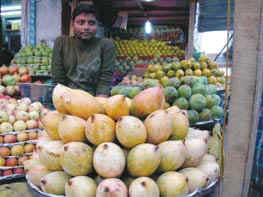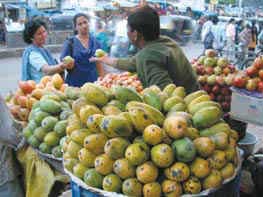India
The Khaas Aam

Ode to the mango, India's regal fruit.
|
Fruits are about sin and temptation. Whether it’s the apple in the Western world, the grapes of Arabia or the Mango in the subcontinent, Mother Nature tempts you with her wholesome stuff. But these sticky-fingered desserts also evoke associations which are not just culinary.
The apple symbolizes original sin and purity, simultaneously sensuality and innocence. Wine, woman and song are incomplete without a bunch of grapes in all things Arabian. In India, it is the Mango that is woven into art, emotions and the palate of the culture. Each phase in the life of a mango – a tree in full flower, the first tiny mangoes, the kathci kairi (raw mango) and the ripe full sweet fruit – has been marked and celebrated by different folk songs. It can be transformed into pickles and pana, dried to form tangy amchur, eaten with juice running down the fingers or with great delicacy after being cut into cubes and dunked into milk for an exquisite milk shake. Its botanical name “Mangifera Indica” is a testimony to its Indian origin. The Tamil word for it is close, “mangay.” In Chinese it is “mang-two.” Assamese call it “ghari’, in Karnataka it is known as “mavu” and in Malayalam it is called “amra.” It would not be wrong to classify Lucknow as a cultural center of the north. It is also one of the most important nodes for the growth of the mango. For this favoured city of the Nawabs was the precursor of a lifestyle in the 19th and 20th century. In the Awadh province, summers and winters not only meant the climatic differences between extreme heat and cold, but defined routines too. Winter meant “lihafs” (quilts), “gajak” and afternoons spent on the “charpai” in the sun. And after the cocooned winter summer spelt freedom with thin “malmal” dupattas, bucketsful of delicious mangoes soaked overnight and swings on numerous mango trees, which would bring back married daughters to their “maikas.”
Mango featured prominently in this way of life dedicated to luxury, not just as a summer delicacy, but its richness and many varieties finding their way into the many-flavoured lifestyle of the Nawabs. And it showed, in the way the varieties flowered. Some took the names of the Nawabs who favoured them and of their subjects who showered their patronage. The fruit took on nicknames, only reserved for a favoured child, such as Krishna Bhog, Sharifa, Balhar, Jauhari, Shamsul Asmar, Khasa, Prince, Karela, Kalwa Pahari, Surkha, Amin Dandewali, Taimur lung, Imamuddin Khan, Bemisaal, Ram Bhog, Langraor, Aeb-e-Hayat, Gol Bhadiyaan, Khajra Kamaal, Dosada Bhadri, and Halwa. The south also has its varieties. From the luscious yellow “banganapalli” to the red tinged “pithar.” Andhra has the “udadha” and the “jivadu.” Salem has “sindura” and “kalapadi.” “Bangalora” as its name suggests is from Bangalore – a reddish coloured fruit with a sweet sour taste. A variety of mangoes are found in Assam, Manipur, Tripura, Mizoram, Chittagong hill tracts and Rajshahi & Chapai Nawabganj districts in eastern India and Bangla Desh. The southern humid tropical areas of Andaman & Nicobar Islands, south Madhya Pradesh, Kerala, Western Ghats are the second centre of mango origin in the world. Uttar Pradesh, Bihar, Gujarat, Maharashtra, Rajasthan and Punjab and Sindh in Pakistan are other major areas of mango production. Two of the smallest and largest varieties – moti dana (literally, pearl sized weighing two grams) and jam-e-jam (four kilos) have been grown by fruit farmer Javed Farukh Faridi in his farm in Rataul near Delhi. There are different seasons for different mangoes. Bewtween January to May mangoes like pairi, neelam, totapuri and banganpalli come from South India. Alphonso also makes an entry. From June to August it is time for safeda, siroli, chausa, langra, dussehri and malda from Uttar Pradesh, Bihar and West Bengal.
In August before the fruit disappears, there is the fazli. A single mango of this kind weighs a kilogram, even more. Today, India produces some 10 million tonnes of mangoes annually, accounting for 52 per cent of the world output. It tickles most palates and even succeeded in capturing the British imagination, along with spices, silks and Shami kebabs. Kalidas sang its praises, Alexander the Great relished its taste and Mughal Emperor Akbar planted 100,000 of them in Darbhanga, the grove was called Lakhi Bagh. Praised in the Vedas as a heavenly fruit, mango symbolised everything from luxury to fertility and was used liberally in poetry, art and even fashion. The mango is the one thing to look forward to during the Indian summer, greater than even the temptations of the watery melon. It had its place in mythology too. Buddha’s most famous female disciple is called Amrapali. The mango tree is carved on the Sanchi stupa [150 B.C]. Buddha was born near a mango grove at Lumbini [563 B.C]. Historians trace its usage in literature with words like Vasantaduta (messenger of spring), Madhuduta (messenger of fragrance), Kamang (cupid), Kokilavasa (abode of the Koel), and Kamavallabha (amorous). There are other uses to the mango too. A string of mango leaves hung outside the main door is considered auspicious. They form an integral part of the decoration during festivals and occasions. Langda, literally means lame originated from a chance seedling near Benares city. Amman Dussehri comes from a village near Malihabad. Other varieties of this name include Laila Majnu, Hussanara and the saunf like Saufiya. Samar Bahisht or the fruit of paradise comes from an area near Muzaffar Nagar. Anwar Rataul from a garden in Rataul is smaller than an apple and sweet as sin. Alfonso from Maharashtra is often considered the Royal among all mangoes. And is largely exported due to its longer shelf life. Fazli is a large mango weighing up to 1.5 kg. Banganpalli, also called Baneshan, Chapta, Chapatai and Safeda in the North is a good large-sized fruit. Malgova is very suitable for making preserves. Swarnarekha from coastal Andhra Pradesh is also Sundari or Sandhuri in the Delhi market. Payri is from the Konkan coast and more expensive than the Alphonso. Kesar from Gujarat is fleshy and large. Dalimbi is a colourful mango from Valsad region. Totapuri and badam are very cheap. Totapuri can be transported loose without packing. |



